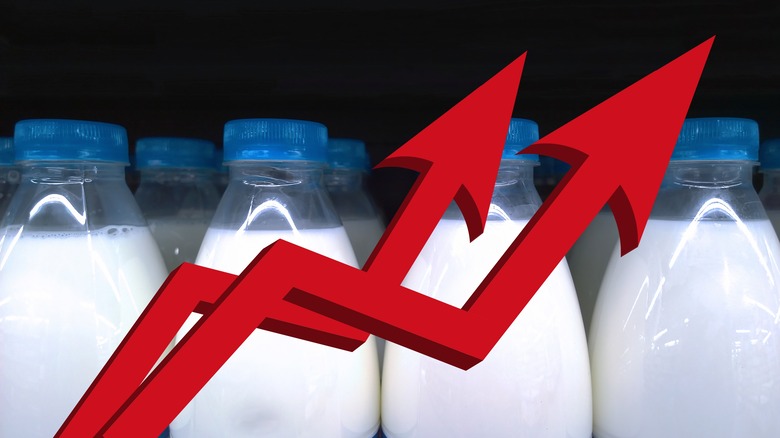The Huge Role That Grocery Stores Play In Determining Milk Prices
When visiting your local grocery store, you may wonder how prices are set for the products you buy. Take milk, for instance, a common feature of many shopping lists. The American Dairy Association details the voyage milk takes from the farm to your home, which entails growing crops to sustain cows, caring for the cows that produce milk, transporting the milk to a processing plant, pasteurizing and bottling milk, and finally taking the finished product to a local supermarket, where it can be purchased by you.
As you can imagine, this process requires quite a bit of money and according to PennState Extension, processing costs are just one of many factors that dictate the price of milk on grocery store shelves. Market fluctuations, federal mandates, supply chain issues, consumer demand, and importation can all play a role. Grocery stores also have a significant impact on the price of milk, often to the detriment of the farms that supply it.
How supermarkets affect the price milk
Very few people these days buy their dairy products direct from suppliers, meaning farms. Accordingly, most milk makes a stop at the local grocery store or popular supermarket chain before landing on your table. According to a report by Oxfam, supermarkets wield lots of authority when it comes to their suppliers, and also take a large share of the profits. Stores want to keep prices low to entice customers, which results in pressure on the farms producing milk. Stores also expect suppliers to keep up with strict regulations and rules, which drives up operating costs. Consider the share that grocery stores take when a consumer buys milk or some other farm-supplied item. Farmers typically take 13.9% of the sale, while supermarkets take a whopping 30.1%.
The outsized authority of supermarkets also negatively affects the dairy industry and the farms that produce milk. As explained by Time, Americans are drinking less milk these days, with total consumption for 2018 down 26% from the year 2000. As a result, many farms are being forced to file for bankruptcy, including massive manufacturers like Borden Dairy. One major issue is the current increase in milk prices, which causes consumption to dip even lower.
Why the price of milk may be on the rise
Despite the desire to keep milk prices low, global unrest has resulted in an increase in pricing all over the world. CNN states that the retail price for milk increased by 15% in 2022, while wholesale pricing saw an increase of 38%. Issues with the supply chain during the pandemic contributed to price hikes, as did factors like the war in Ukraine and new farming rules.
While consumers are definitely not happy about rising prices, supermarkets are even less so. According to Marketplace, these concerns about the increasing price of milk have led many chains, including giants like Walmart and Kroger, to develop their own dairy farms for milk production. While it might seem counterintuitive, as running a dairy farm requires a lot of money, it actually allows supermarkets to increase profits in other ways. For instance, Marketplace notes that many stores sell milk under cost while raising prices on other items. While this practice keeps milk costs low and increases profits for grocery stores, it harms dairy producers even further, as they simply cannot keep up with the ultra-low prices.


